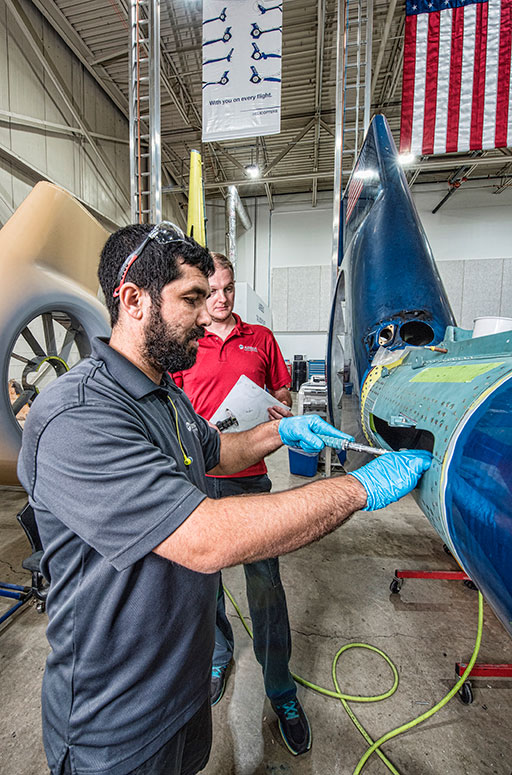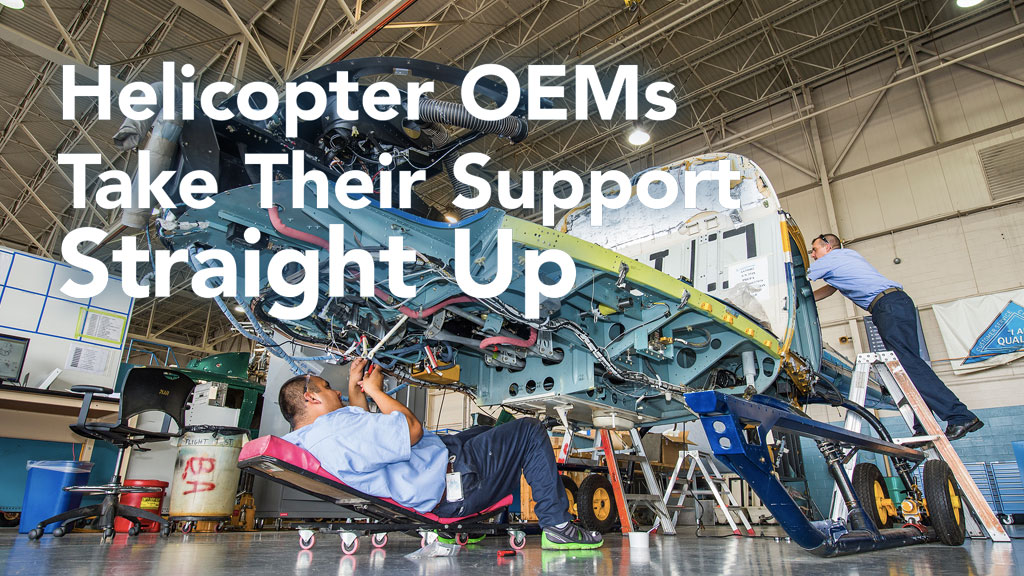Aviation Maintenance takes a look at some of the changes helicopter manufacturers are making to improve the ongoing maintenance of their aircraft in the field.
Not to overstate the obvious, but helicopters are extremely complex flying machines. And being such, they require a lot of maintenance. Helicopters have a large number of moving parts, designed for minimal weight and high stress (fatigue) conditions. Even the “simplest” light helicopter like a Robinson R22 is a true marvel of mechanical engineering.
This, combined with a low tolerance for failure, results in high maintenance rates and costs. In a published report, the U.S. Army stated that its Ratios of Maintenance Man Hours (MMH) to flight hours for light turbine helicopters averages 4:1. Of course, those helicopters are operating in the most extreme conditions, but still, no wonder helicopters have to work hard for their keep.
Of course, this is no news to the helicopter manufacturers. There’s no question that they invest countless resources developing ways to bring that ratio closer together. One way they are progressing in that direction is by continually looking for ways to optimize their maintenance practices.
Aviation Maintenance contacted some of the helicopter manufacturers to see what they have introduced to help maintenance technicians in the field to do their jobs faster, safer and more efficiently.
Airbus Helicopters Goes Digital with Keycopter
Airbus Helicopters are in service in every corner of the globe and some of those locations are pretty remote. To make it easier for maintainers to access the information they need wherever they are the company has replaced 90-plus percent of its paper maintenance manuals with digital files.
“Keycopter is our online portal for our customers and maintainers,” explained Darren Huski, systems support specialist and trainer, Customer Support for Airbus Helicopters, Inc. “Users now log into their Keycopter account and that gives them access to Orion – that is where they find all the latest manuals and instructions.”


Huski said that one of the problems technicians have is ensuring the instructions they have are the most up-to-date and Orion eliminates that worry. The digital files are a current as possible. And to aid in field maintenance, Airbus has created a series of apps that enable technicians to download all the appropriate files onto their tablet or even smartphone.
“If you don’t have Internet access where you are working, you can just download the information on your iPad,” he said. “It’s like having a mobile repair manual. It’s a big thing with our customers and they really like it.”
Huski also explained that digitizing the manuals aren’t the only new-generation capabilities Airbus is introducing. The company has recently introduced animated 3D maintenance videos for their H175 helicopter.
“We think this is the future of maintenance manuals,” he said. “People learn so much faster if you show them how to do something. Technicians can not only see what’s being done, they can actually spin it around to see the activity from different angles.”
“This is what today’s technology will allow, and we think it’s a whole lot better than paper,” Huski said. “Right now, it’s only available on one of our aircraft, but you’re going to see a lot more of it down the road.”
Another new digitally based tool Husky is excited about is Airbus Helicopter’s new E-Dynamic Troubleshooting capability.
“With paper instructions, you would have to read through the various troubleshooting steps and follow the process on the aircraft,” he said. “That’s extremely time-consuming and can be challenging in remote locations. With the E-Dynamic you basically answer some questions that the app gives you and, depending on your answers, it steps you through the process until you reach the most probable cause for the problem.”
“No matter what you are doing, E-Dynamic greatly simplifies and streamlines the troubleshooting process,” Huski said. “It can really save the technician a lot of time, which reduces maintenance costs and aircraft downtime.”
Another digital tool that will save technician’s time is Orion’s link to the Airbus Helicopters’ illustrated parts catalog. Huski said that when a technician is working on a task, if they need to order parts, they can just click on what they need and Orion will create a complete parts list that can be instantly sent to the operator’s purchasing department.
“It saves time and eliminates the possibility of a busy technician inadvertently writing down the wrong part number,” he said.
Bell Helicopter Makes Old-School Cool
As complex as helicopters are, it’s hard to argue with Bell Helicopter’s ongoing commitment to providing its customers and their maintainers with the best hands-on training possible. And at the heart of this commitment is the virtual fleet of “practical” aircraft maintenance trainers found in their state-of-the-art Bell Helicopter Training Academy in Fort Worth, Texas.
As Ray Lamas, Bell’s general manager, Maintenance Training explained it, the practical trainers are actual helicopter airframes with all their components installed, which gives students the opportunity to get hands-on experience with all types of inspections and repairs.
“We believe that hands-on training is the best type of training,” he said. “In fact, over half of our training program is focused on hands-on skill enhancing and performance-focused instruction with the practical trainers.”
While airframe inspection and repair garners the majority of the training time, Bell recognizes that dealing with advanced avionics is becoming a larger part of the field maintainers’ responsibility. To that end, the company recently introduced two new avionics bench trainers to the curriculum.

“One avionics trainer is for the Garmin G1000H-equipped Bell 407GX and the other is for the Bell 412EPI, which features our own BasiX Pro Integrated Avionics System,” Lamas said. “The two trainers were custom-built for us by TRU Simulation and Training.”
“The advantage of the bench training devices is that we can take the glass cockpit out of the cockpit and give the students the opportunity to get much more hands-on training,” he said. “They can go through all the avionics maintenance pages. We can introduce faults to allow the students to get practical, hands-on troubleshooting practice and lead them through to a solution of changing an LRU or removing an entire console and replacing it with a new one.”
Lamas also said that the combination of the practical airframe trainers and the new avionics trainers allows instructors to leverage classes on airframe systems common to both a legacy analog Bell 412 and a new digital 412EPI and then introduce the increased troubleshooting needs of the 412EPI’s advanced avionics.
“This is the type of training our customers have been wanting for a long time,” Lamas said. “Now we are offering it in our training academy here in Texas and plan to offer it at our facility in Singapore in the near future.”
Lamas stressed that while Bell is committed to continually improving it’s hands-on training, it is also exploring ways to use advanced technologies to enhance that experience.
“We know it is inconvenient and expensive for our customers to send technicians to us for training, so we are working to find ways to effectively deliver our classroom content via an online system,” he said. “By allowing students to cover this content prior to coming to our facilities, we can shorten the time they are away from their jobs.”
MD Helicopters Standardizes Mx Forms
One of the biggest challenges for helicopter maintainers always seems to be the inconsistencies they encounter with various third-party maintenance tracking forms. They can spend way too much time just trying to figure out what’s what?
MD Helicopters, Inc. (MDHI) has taken a major stride in simplifying these tasks by standardizing all of its maintenance forms and information and locating it all on their new web portal, MyMD.aero.
“Because these templates were built by the factory, maintainers can enjoy an increased level of confidence related to tracking components and inspections for the aircraft,” stated Nick Nenadovic, vice president, Aftermarket & Customer Support at MDHI. “We’ve introduced standardized maintenance templates for all of our aircraft. The information was built off the airworthiness limitations from chapters four and five of our Handbook for Maintenance Instructions.”
Another benefit to information standardization is the added efficiency of streamlined parts procurement, which is integral to keeping helicopters operational.
“Because the global MD community is tight knit, the more operators that use the MyMD templates, the greater visibility we, as the OEM, will have into the future replacement parts needs of our customers,” Nenadovic said.
He also explained that MDHI is using this real-fleet data to forecast which parts the MD fleet will be needing and when. “The MDHI procurement team can lean forward and work with suppliers to accurately forecast future demand and negotiate quantity discounts, which would then be passed along to our customers,” he said. “It’s a win-win for all parties.”
Another change MDHI recently made was to partner with Aircraft Technical Publishers (ATP) to deliver all of its technical publications via the MyMD.aero portal.
“MyMD.aero leverages the advanced Single Sign-On (SSO) of ATP’s Aviation Hub cloud solution, which gives MD helicopter operators greater accessibility to the critical maintenance-related information they need to keep their aircraft safe and airworthy,” Nenadovic said. “Because the information can be accessed on a desktop, tablet or smartphone, technicians have access to the instructions they need whether working out in a remote field or a full-service hangar.”
In addition to remote accessibility, Nenadovic explained that the portal has a new Airworthiness Directive and Service Bulletin tracking capability right on the dashboard, which makes it quick and easy to see any new AD or SB.

“It also lets the operator set custom AD, SB and SL (Service Letter) tracking reminders so they will automatically receive notifications whenever they are issued,” Nenadovic said. “That way they’ll never miss an update again.”
Robinson Goes “Local” for International Training
With somewhere over 12,000 helicopters operating in every conceivable corner of the world, the task of training a literal army of technicians is something the Robinson Helicopter Company takes very seriously. And to help ensure that their helicopters will deliver the safe and reliable performance every customer expects Robinson runs its own maintenance ‘college’ at its Torrance, Calif., headquarters.
While Robinson’s in-house maintenance program is described as a “basic hands-on” course for the inspection and maintenance of R22, R44 and R66 airframes, Patrick Cox, manager, Technical Support, Robinson Helicopter Company, explained that the course is only available to technicians who already hold a valid A&P license or are active duty military with equivalent knowledge.
“We discourage owners from attending unless they have a valid technician’s certificate,” he said. “It’s way too technical if you don’t already posses the knowledge and skills. If they do have a certificate, then they’re welcome to pay the tuition and attend.”
While Robinson helicopters are found in pretty much every corner of the world, Cox explained that the Torrance facility doesn’t get many internationally based technicians for a variety of reasons.
“Depending on what country they are coming from it can be very difficult for students to come here for training,” Cox said. “And more importantly than that, it costs a lot to send someone half-way around the world to get training.”
So instead of requiring a factory-visit, the company ‘partners’ with two authorized facilities to offer training for internationally-located technicians.
“We have Mornington Sanford Aviation, which is based in Malaysia, handle all of the training for southeast Asia and Heli Air in the U.K. for Europe and the Middle-East,” he said. “Besides their geographic benefits, both of these companies are authorized to provide EASA-compliant maintenance training.”
“The EASA training requirements have become quite onerous now,” Cox said. “EASA requires much more practical experience than we can provide here. It’s not just hands-on training. They require line-type training if you will. We’re not set up to do that.”
“So if a technician requires EASA certification, then we refer them to either of the EASA approved schools,” Cox said. “Both are also an authorized Robinson dealers and service centers.”
Cox said that another step that the company has made that will hopefully make every Robinson Helicopter technician’s life easier is to streamline its parts ordering process.
“Helicopter downtime is critical, so we’ve made strides in filling orders faster,” he said. “We’ve bar-coded all of our spares inventory so we can locate parts faster and track their shipment better. It’s old news to many folks, but the bottom line is we’re much faster on filling orders now.”
Sikorsky Introduces Sikorsky360 – an Interactive Portal
With a 90-plus year history and a global fleet of thousands of helicopters, Sikorsky has a really deep pool of data to pull from when it comes to understanding and forecasting the maintenance needs of its operators. And all of that information resides in its new Customer Care Center in Trumbull, Connecticut.
“It’s the new nerve center of our customer support operations for our commercial operators,” explained Simon Gharibian, director, Fleet Management, Supportability and Training for Sikorsky. “One of the areas is the Fleet Management room where we are pulling data from all of our operators, whether it’s digital data from the aircraft HUMS (Health and Usage Monitoring System) or maintenance history through business-to-business connections.”
“We’re continually aggregating that data to come up with a picture to help forecast maintenance needs and what parts we need to stock where in the world,” he said. “We recently layered that information with our next generation customer portal called Sikorsky360 and introduced it at last year’s NBAA Convention. While there’s a lot of information on the site, key to maintainers is it is now where they will find our web-based, interactive maintenance manuals.”
“Now maintainers can connect to Sikorsky360 and view or download the latest maintenance information the form of next-generation interactive electronic technical manuals (IETM),” Gharibian said. “To help the maintainer even further, the IETM is coupled with the aircraft HUMS ground station so you can literally take the fault code directly from the system and quickly troubleshoot it via the interactive manual.”
“Technicians can now easily pull up the exact maintenance activities to resolve the issue,” he said. “In many cases there is also photo and video content that will walk you through the entire maintenance procedure.”
Gharibian also explained that the IETM portal on the Sikorsky360 portal also provides the technician with a list of the necessary parts and consumables required to do the maintenance task. And, an as added bonus, it will automatically order the parts you need.
“The thing that I get most excited about, from a maintenance standpoint, is that we have built this continually improving integrated system that will streamline the entire troubleshooting and maintenance process,” he said. “Now a technician in the field has access to a thorough history of Sikorsky maintenance lessons so they can benefit from what other people have seen and done in the past.”
While the volumes of online information available to a technician is extensive, Gharibian stressed that if they prefer a more personal approach, technicians can always work with their closest regional field support representative or call the Sikorsky Customer Care Center and talk with an experienced technical expert.
